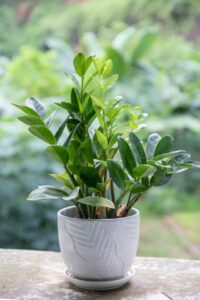ZZ Plant Care Ultimate Guide With Tips
Even if you are interested, you may not have enough time to care for plants in your busy daily life. Then, are you looking for a houseplant to grow without paying too much attention to it? Here’s the best ideal solution for you! Let’s explore everything you should know about ZZ plant care in this article.
What is the ZZ plant? – Zamioculcas zamiifolia overview
The Zamioculcas zamiifolia are fast-growing houseplants with glossy, wide, oval-shaped leaves. They required low maintenance by comparison with most
Houseplants. However, ZZ plant care outdoors is also effortless in a filtered light area with well-draining soil.
The plant is indigenous to Tanzania and Zanzibar in East Africa. The plants are also known as Zanzibar gems because of their spotless waxy leaves and the deep green
colour of their small leaves. This appearance makes it look like an artificial plant; most people confuse it with a plastic or silicon-made plant.
Summer or spring is the ideal season to plant or depot ZZ plants for active and healthy growth. ZZ plants prefer direct, bright sunlight and have a slow growth rate.
The ZZ plant has the advantage of thriving in a variety of lighting situations.
Both people and animals can suffer serious health consequences if they consume any part of these plants. Yeah! There are a lot of facts to know about that plant. So,
Let’s continue to explain all facts about the ZZ plant briefly.

Different variations of ZZ plant
Most ZZ plants have waxy green leaves in common. But the Raven ZZ plant (Z. Zamiifolia ‘Dowon) has dark purple leaves that look almost black. It is a new variety
Grown in North America by Costa Farms.
There is another domesticated ZZ plant variety known as ‘Zamicro,’ which is considerably smaller in size compared to the standard ZZ variety.
Any variation of ZZ plants can combine with many other houseplants, like tall snake plants, which want low-maintenance attention, the same as ZZ plants.
ZZ plant care guide – Water, light, soil, temperature, and
more

As we mentioned above, the ZZ plant is one of the easiest to care for houseplants. However, easy means it would not grow well anywhere and everywhere without any
Attention. So, it would help if you had a clear idea about minimum maintenance guides for ZZ Plants. Here are the water, light, soil, temperature, and fertilizer requirements for the
ZZ plant.
Water conditions
The thick rhizomes of these plants make them very resistant to drought and allow them to survive with little water.
● You should water ZZ plants about once every two weeks when the soil gets completely dry.
● Make sure to water the plant until to the point where it’s dripping out of the pot’s drainage hole.
● However, it is always better to supply less water than most other plants.
Soil conditions – Plant medium
ZZ plants don’t have a lot of preferences for their potting soil as long as it drains well.
● You can plant them in most of the standard potting mixtures without paying special attention to the potting medium.
● It is best to mix some soil metals or sand with the soil mixture to gain a smooth drainage.
Light conditions
ZZ plants can grow in various light levels, making them suitable indoors.
● The best light condition for these plants is low indoor light. They can grow tall quickly in low-light conditions.
● Choose a spot in your house with bright, indirect light. Ideally, in a room with windows that face south.
● Direct sunlight can harm ZZ plants. So, keep your plants away from direct sunlight.
Temperature and Humidity conditions
The average temperatures and humidity levels in homes are acceptable for ZZ plants.
These plants don’t do well in cold temperatures (below 45 ° F).
● So don’t put your plant near drafts or places in your home that are particularly cold.
● ZZ plants don’t need humidity, but if your home is located in a dry area, you might want to buy a humidifier
● You can also place your ZZ plant pot on a tray filled with marbles and water to increase the humidity
Necessity of fertilizers
Most ZZ plants don’t need fertilizers to grow well.
● But if you want to make your plant bigger or stronger, use indoor plant fertilizers diluted to half-strength.
● It is enough to use fertilizer twice during the plant’s active growth period.
● It is good to say again that ZZ plants do not require fertilization. It is optional as per your need.
ZZ Plant Propagation Methods
Plant propagation is a quick and low-cost way to expand your home garden with ZZ plants. You can make more ZZ plants by leaf cutting or division.
Propagate by division
1. Wait until your ZZ plant is ready for reporting.
2. After removing it from its pot, divide the plant’s rhizome roots into two parts.
3. After that, plant each in separate containers.
Propagate by leaf cuttings
1. Take a mature ZZ plant and cut off a leaf stem with a minimum of two leaves.
2. Shallowly bury the cutting in a fresh container filled with moist potting soil.
3. Put your newly grown plant in a warm location with bright indirect light, and water it when the soil becomes dry.
This method of propagating is slower than dividing the plant, which can take around four months to a whole year for rhizomes growth.
ZZ Plant Problems
There are few pests and diseases subject to ZZ plants. Yellow leaf disease is the most common one among them. Yellow leaves disease occurs when you put excess amounts of water into the plant. So, if you are looking for a ZZ plant, and care for yellow leaves, the best thing you should care about is letting the soil dry before the next watering. And keep in mind to always
follow the above watering guides.
However, if its rhizomes and roots appear dark or mushy. In that case, that is a sign of root rot, and you will need to take additional steps, like changing the soil mixture or pot to ensure healthy growth.
Conclusion
ZZ plant is a very popular houseplant in many countries. It can adapt to many environmental conditions by comparison with most plants. So, ZZ plant care is effortless. It does not require too much water or light to grow. And it will grow in any common soil mixture you use to plant other plants. Using fertilizers is optional for these plants. However, a few problems come with ZZ plants, such as yellow leaves diseases and root rotting problems


